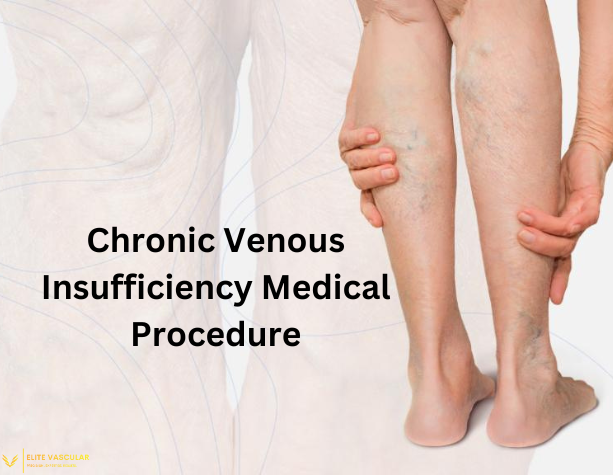What Is Chronic Venous Insufficiency?
Chronic venous insufficiency, a vascular condition, is caused by insufficient vein valve function. In veins that are in excellent condition, valves control blood flow. They return blood to your heart from your legs, where it has been depleted of oxygen. These valves may get broken and stop working as effectively as they should. Some of the deoxygenated blood may go down the legs rather than returning to the heart.
Chronic venous insufficiency causes the veins in the legs to become larger and distended over time. As the blood pools, it may cause more harm to the veins that are already failing. Chronic venous insufficiency worsens over time if left untreated. Blood clots, another frequent side effect of the condition, are also potentially fatal. This is why it is critical to get treatment for chronic venous insufficiency as soon as feasible.
Different Stages of Chronic Venous Insufficiency
In order to classify CVI symptoms, the Clinical-Etiology-Anatomy-Pathophysiology framework is used. The severity of your symptoms, and hence the therapy you should get, will be rated on this scale by your doctor.
CVI Starting Stage: The patient may have leg heaviness or pain but no evidence of chronic venous insufficiency. This is the mildest variant.
CVI stage 1: Threadlike veins visible on the skin’s surface are common in patients at this stage. Other symptoms, such as leg soreness, edema, or heaviness, may suggest chronic venous insufficiency.
CVI stage 2: Patients’ leg veins are significantly swollen at this stage. Varicose veins may be very painful.
CVI Stage 3: Lower extremity edema is common at this period. When arterial pressure rises, veins leak fluid into leg tissues. Lower extremity swelling may occur.
CVI Stage 4: During this period, people often develop skin discoloration or inflammation. The lower extremities may seem brownish. It is also possible to have red splotches on the skin. Scarring or a rash-like appearance may occur on some regions of the legs.
CVI Stage 5: Leg ulcers have healed, and the patient is exhibiting signs of recovery.
CVI Stage 6: Open venous ulcers are common at this time. Weeping or big ulcers may spread infection. This is the worst part.
Ulceration is a clinical manifestation of insufficient blood circulation to the legs. When the body’s capacity to pump blood to the legs is weakened, clots form. Infection-related ulcers may need antibiotics or surgery. These issues may be avoided with chronic venous insufficiency medical procedure.
Chronic venous insufficiency causes and risk factors
Chronic venous insufficiency is caused by valves that are weak or broken. These are some things that can put valves at risk of becoming weak or broken:
- History of varicose veins in oneself or immediate family members
- 50 years of age or older
- Being a woman
- Obesity, Smoking and Pregnancy
- Deep vein thrombosis (DVT), a vein clot under the skin
- Long durations of sitting or standing
- Lacking physical activity
Noninvasive Chronic Venous Insufficiency Treatments
During the first phases of chronic venous insufficiency, implementing lifestyle modifications and using self-care techniques may suffice to alleviate symptoms.
Elevate your legs: Whether you’re sitting or laying down, keeping your legs at a comfortable height is important. This enhances blood circulation by alleviating venous pressure.
Maintain good skin hygiene: Patients with persistent venous insufficiency often develop ulcers. Infected lesions may occur. Keep skin clean to prevent infections. Your doctor will advise you on ulcer infection prevention. If you have venous insufficiency, see your doctor before using skin or bath products.
Minimize prolonged periods of sitting and standing: Prolonged periods of sitting or standing might worsen symptoms. To decrease the blood pressure in your legs, it is recommended to take regular breaks and raise your feet. Compression stockings might provide advantages if your occupation requires prolonged periods of standing or sitting.
Exercise regularly: Maintaining leg circulation requires regular exercise. Maintaining blood circulation may prevent venous ulcers and other issues. Chronic venous insufficiency sufferers may benefit from walking. Consult your doctor to discover the best workout for you.
Consider compression stockings: Compression stockings hug legs. They prevent blood from flowing backward, improving circulation. This may relieve leg pain and edema in chronic venous insufficiency patients. First-time compression stocking wearers should see a doctor.
Maintain a healthy weight: Overweight hurts leg veins. Heavy carrying may worsen venous insufficiency. If you’re overweight, ask your doctor about safe weight loss.
Low-Invasive Chronic Venous Insufficiency Treatments
The consequences of minimally invasive procedures meant to stop blood from flowing backward in the vein include reduced venous pressure and enhanced blood flow to the legs. General anesthesia may not be required to provide these advantages. Some possible therapies for chronic venous insufficiency include the following:
Radiofrequency vein ablation: RVA utilizes a tiny catheter to deliver radiofrequency radiation into the vein, thereby occluding it. Once the vein becomes obsolete for blood circulation, it will gradually diminish in size and ultimately be assimilated by the body.
Endovenous laser therapy: RVA and EVLT are comparable processes. EVLT seals off blood flow by using laser radiation, not radiofrequency energy, to shut the damaged vein. The vein will then contract and vanish, much as in RVA.
Sclerotherapy: For sclerotherapy, an intravenous injection of a drug is performed. The medication induces tissue irritation and fibrosis. Due to the obstruction of blood flow caused by the fibrosis, the vein progressively diminishes in color.
Angioplasty and Venous Stripping: If your symptoms are severe, your vascular surgeon may suggest venous stripping or angioplasty. Angioplasty is used to clear a blocked vein, whereas venous stripping is utilized to eliminate a dysfunctional vein.
